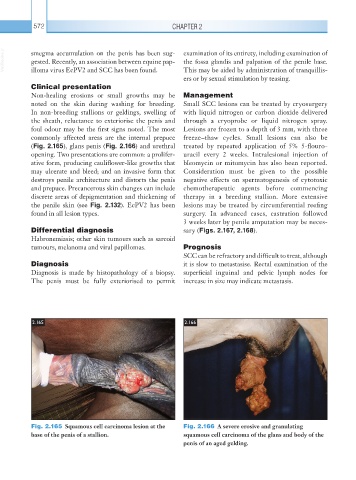Page 597 - Equine Clinical Medicine, Surgery and Reproduction, 2nd Edition
P. 597
572 CHAPTER 2
VetBooks.ir smegma accumulation on the penis has been sug- examination of its entirety, including examination of
the fossa glandis and palpation of the penile base.
gested. Recently, an association between equine pap-
illoma virus EcPV2 and SCC has been found.
This may be aided by administration of tranquillis-
ers or by sexual stimulation by teasing.
Clinical presentation
Non-healing erosions or small growths may be Management
noted on the skin during washing for breeding. Small SCC lesions can be treated by cryosurgery
In non-breeding stallions or geldings, swelling of with liquid nitrogen or carbon dioxide delivered
the sheath, reluctance to exteriorise the penis and through a cryoprobe or liquid nitrogen spray.
foul odour may be the first signs noted. The most Lesions are frozen to a depth of 3 mm, with three
commonly affected areas are the internal prepuce freeze–thaw cycles. Small lesions can also be
(Fig. 2.165), glans penis (Fig. 2.166) and urethral treated by repeated application of 5% 5-flouro-
opening. Two presentations are common: a prolifer- uracil every 2 weeks. Intralesional injection of
ative form, producing cauliflower-like growths that bleomycin or mitomycin has also been reported.
may ulcerate and bleed; and an invasive form that Consideration must be given to the possible
destroys penile architecture and distorts the penis negative effects on spermatogenesis of cytotoxic
and prepuce. Precancerous skin changes can include chemotherapeutic agents before commencing
discrete areas of depigmentation and thickening of therapy in a breeding stallion. More extensive
the penile skin (see Fig. 2.132). EcPV2 has been lesions may be treated by circumferential reefing
found in all lesion types. surgery. In advanced cases, castration followed
3 weeks later by penile amputation may be neces-
Differential diagnosis sary (Figs. 2.167, 2.168).
Habronemiasis; other skin tumours such as sarcoid
tumours, melanoma and viral papillomas. Prognosis
SCC can be refractory and difficult to treat, although
Diagnosis it is slow to metastasise. Rectal examination of the
Diagnosis is made by histopathology of a biopsy. superficial inguinal and pelvic lymph nodes for
The penis must be fully exteriorised to permit increase in size may indicate metastasis.
2.165 2.166
Fig. 2.165 Squamous cell carcinoma lesion at the Fig. 2.166 A severe erosive and granulating
base of the penis of a stallion. squamous cell carcinoma of the glans and body of the
penis of an aged gelding.

